Investigating the Visual Behavior Characteristics of Architectural Heritage Using Eye-Tracking
Abstract
:1. Introduction
2. Materials and Methods
2.1. Study Area
2.2. Experiment Preparation
2.2.1. Photograph Selection
2.2.2. Participants
2.3. Procedure
2.4. Data Analysis
2.4.1. Eye-Tracking Metrics Selection
2.4.2. Defining AOI
3. Results
3.1. Visual Behavior Characteristics of Participants When Viewing Architectural Heritage in Different Scenes
3.1.1. Differences in the Eye Movement Metrics of Architectural Heritage in Different Scenes
3.1.2. Fixation Characteristics of Architectural Heritage in Different Scenes
3.2. Visual Behavior Characteristics of Elements
3.2.1. Differences in the Eye Movement Metrics of Different Elements
3.2.2. Differences in Fixation Characteristics of the Same Elements in Different Scenes
3.3. Reasons for Differences in Visual Perception
4. Discussions
5. Conclusions
Author Contributions
Funding
Informed Consent Statement
Acknowledgments
Conflicts of Interest
References
- UNESCO World Heritage Centre. Decision—26 COM 9. Available online: https://whc.unesco.org/en/decisions/1217/ (accessed on 29 April 2022).
- Grazuleviciute-Vileniske, I. Influence of Built Heritage on Sustainable Development of Landscape. Landsc. Res. 2008, 33, 425–437. [Google Scholar] [CrossRef]
- Urry, J.; Jonas, L. The Tourist Gaze 3.0; SAGE Publications: London, UK, 2002. [Google Scholar]
- Golkar, K. Conceptual Evolution of Urban Visual Environment; From Cosmetic Approach Through To Sustainable Approach. Environ. Sci. 2008, 5, 95–113. [Google Scholar]
- Tavernor, R. Visual and Cultural Sustainability: The Impact of Tall Buildings on London. Landsc. Urban Plan. 2007, 83, 2–12. [Google Scholar] [CrossRef]
- Chen, S. Research on the Rural Visual Landscape and Its Planning. Master’s Thesis, Zhejiang University, Hangzhou, China, 2010. (In Chinese). [Google Scholar]
- Zheng, W. Research on the Attraction of Rural Landscape Based on Tourism View. Ph.D. Thesis, Huazhong Agricultural University, Wuhan, China, 2009. (In Chinese). [Google Scholar]
- Nemeth, L. Towards a Humane Architecture by Bruce Allsopp (Review). Leonardo 1975, 8, 353. [Google Scholar]
- Rodrigues, M.S.; Lay, M.C.D. Perception and Evaluation of Visual Quality of the Urban Landscape in Historic Areas. Measuring Heritage Conservation Performance; Rome, ICCROM. 2012, pp. 99–101. Available online: https://www.yumpu.com/en/document/read/21844031/measuring-heritage-conservation-performance-iccrom (accessed on 29 April 2022).
- Motevalian, N.; Yeganeh, M. Visually Meaningful Sustainability in National Monuments as an International Heritage. Sustain. Cities Soc. 2020, 60, 102207. [Google Scholar] [CrossRef]
- Mansuri, L.E.; Patel, D.A. Artificial Intelligence-Based Automatic Visual Inspection System for Built Heritage. Smart Sustain. Built Environ. 2021. [Google Scholar] [CrossRef]
- Lopes, A.S.; Macedo, D.V.; Brito, A.Y.S.; Furtado, V. Assessment of Urban Cultural-Heritage Protection Zones Using a Co-Visibility-Analysis Tool. Comput. Environ. Urban Syst. 2019, 76, 139–149. [Google Scholar] [CrossRef]
- Jerpåsen, G.B.; Larsen, K.C. Visual Impact of Wind Farms on Cultural Heritage: A Norwegian Case Study. Environ. Impact Assess. Rev. 2011, 31, 206–215. [Google Scholar] [CrossRef]
- Katahenggam, N. Tourist Perceptions and Preferences of Authenticity in Heritage Tourism: Visual Comparative Study of George Town and Singapore. J. Tour. Cult. Change 2020, 18, 371–385. [Google Scholar] [CrossRef]
- Ji, Y.; Gu, Q.; Liu, Z. Beautiful Countryside Planning Technique Guideline. Planners 2015, 31, 128–133. (In Chinese) [Google Scholar]
- De Kock, P. The Meaning in Seeing: Visual Sustainability in the Built Environment; Education, Design and Practice–Understanding skills in a Complex World; AMPS: New York, NY, USA, 2019. [Google Scholar]
- Wang, M.; Zhao, M.; Lin, M.; Cao, W.; Zhu, H.; An, N. Seeking Lost Memories: Application of a New Visual Methodology for Heritage Protection. Geogr. Rev. 2020, 110, 556–574. [Google Scholar] [CrossRef]
- Liu, L.; Wu, M.; Ma, Y.; Qu, H. A Review of Eye Tracking Researches in Landscape Architecture Field. J. Hum. Settl. West China 2021, 36, 125–133. (In Chinese) [Google Scholar] [CrossRef]
- Zhang, W.; Liang, Q.; Fang, H.; Zhang, Q. An Eye-movement Research on City Greening Landscape Appreciation. Psychol. Sci. 2009, 32, 801–803+800. (In Chinese) [Google Scholar] [CrossRef]
- Duchowski, A.T. A Breadth-First Survey of Eye-Tracking Applications. Behav. Res. Methods Instr. Comput. 2002, 34, 455–470. [Google Scholar] [CrossRef]
- Wang, P.; Yang, W.; Wang, D.; He, Y. Insights into Public Visual Behaviors through Eye-Tracking Tests: A Study Based on National Park System Pilot Area Landscapes. Land 2021, 10, 497. [Google Scholar] [CrossRef]
- Dupont, L.; Antrop, M.; Van Eetvelde, V. Does Landscape Related Expertise Influence the Visual Perception of Landscape Photographs? Implications for Participatory Landscape Planning and Management. Landsc. Urban Plan. 2015, 141, 68–77. [Google Scholar] [CrossRef] [Green Version]
- Gao, Y.; Zhang, T.; Zhang, W.; Meng, H.; Zhang, Z. Research on Visual Behavior Characteristics and Cognitive Evaluation of Different Types of Forest Landscape Spaces. Urban For. Urban Green. 2020, 54, 126788. [Google Scholar] [CrossRef]
- Guo, S.; Sun, W.; Chen, W.; Zhang, J.; Liu, P. Impact of Artificial Elements on Mountain Landscape Perception: An Eye-Tracking Study. Land 2021, 10, 1102. [Google Scholar] [CrossRef]
- Zhou, S.; Gao, Y.; Zhang, Z.; Zhang, W.; Meng, H.; Zhang, T. Visual Behaviour and Cognitive Preferences of Users for Constituent Elements in Forest Landscape Spaces. Forests 2022, 13, 47. [Google Scholar] [CrossRef]
- Gholami, Y.; Taghvaei, S.H.; Norouzian-Maleki, S.; Mansouri Sepehr, R. Identifying the Stimulus of Visual Perception Based on Eye-Tracking in Urban Parks: Case Study of Mellat Park in Tehran. J. For. Res. 2021, 26, 91–100. [Google Scholar] [CrossRef]
- Yi, T.; Chang, M.; Hong, S.; Lee, J.-H. Use of Eye-Tracking in Artworks to Understand Information Needs of Visitors. Int. J. Hum. Comput. Interact. 2021, 37, 220–233. [Google Scholar] [CrossRef]
- Balocco, C.; Farini, A.; Baldanzi, E.; Volante, G. Light, Information and Perception inside Historical Buildings. A Case Study. IOP Conf. Ser. Mater. Sci. Eng. 2018, 364, 012007. [Google Scholar] [CrossRef]
- Fontoura, P.; Menu, M. Visual Perception of Natural Colours in Paintings: An Eye-tracking Study of Grünewald’s Resurrection. Color Res. Appl. 2021, 46, 582–594. [Google Scholar] [CrossRef]
- Reitstätter, L.; Brinkmann, H.; Santini, T.; Specker, E.; Dare, Z.; Bakondi, F.; Miscená, A.; Kasneci, E.; Leder, H.; Rosenberg, R. The Display Makes a Difference: A Mobile Eye Tracking Study on the Perception of Art before and after a Museum’s Rearrangement. JEMR 2020, 13. [Google Scholar] [CrossRef] [PubMed]
- Gartus, A.; Klemer, N.; Leder, H. The Effects of Visual Context and Individual Differences on Perception and Evaluation of Modern Art and Graffiti Art. Acta Psychol. 2015, 156, 64–76. [Google Scholar] [CrossRef] [PubMed]
- Dupont, L.; Antrop, M.; Van Eetvelde, V. Eye-Tracking Analysis in Landscape Perception Research: Influence of Photograph Properties and Landscape Characteristics. Landsc. Res. 2014, 39, 417–432. [Google Scholar] [CrossRef]
- Dupont, L.; Ooms, K.; Duchowski, A.T.; Antrop, M.; Van Eetvelde, V. Investigating the Visual Exploration of the Rural-Urban Gradient Using Eye-Tracking. Spat. Cogn. Comput. 2017, 17, 65–88. [Google Scholar] [CrossRef]
- De Lucio, J.V.; Mohamadian, M.; Ruiz, J.P.; Banayas, J.; Bernaldez, F.G. Visual Landscape Exploration as Revealed by Eye Movement Tracking. Landsc. Urban Plan. 1996, 34, 135–142. [Google Scholar] [CrossRef]
- Tatler, B.W. The Central Fixation Bias in Scene Viewing: Selecting an Optimal Viewing Position Independently of Motor Biases and Image Feature Distributions. J. Vis. 2007, 7, 4. [Google Scholar] [CrossRef] [Green Version]
- Weber, R.; Choi, Y.; Stark, L. The impact of formal properties on eye movement during the perception of architecture. J. Archit. Plan. Res. 2002, 19, 57–69. [Google Scholar]
- Hasse, C.; Weber, R. Eye Movements on Facades: The Subjective Perception of Balance in Architecture and Its Link to Aesthetic Judgment. Empir. Stud. Arts 2012, 30, 7–22. [Google Scholar] [CrossRef]
- De la Fuente Suárez, L.A. Subjective Experience and Visual Attention to a Historic Building: A Real-World Eye-Tracking Study. Front. Archit. Res. 2020, 9, 774–804. [Google Scholar] [CrossRef]
- Li, Z.; Sun, X.; Zhao, S.; Zuo, H. Integrating Eye-Movement Analysis and the Semantic Differential Method to Analyze the Visual Effect of a Traditional Commercial Block in Hefei, China. Front. Archit. Res. 2021, 10, 317–331. [Google Scholar] [CrossRef]
- Xu, D.; Li, Y. Experts and Public Aesthetic Differences Based on SD-SBE Method. Chin. Landsc. Archit. 2014, 30, 52–56. (In Chinese) [Google Scholar]
- Brumberger, E.R. Eye Tracking Methodology: Theory and Practice. Tech. Commun. 2008, 55, 301–302. [Google Scholar]
- Holmqvist, K.; Örbom, S.L.; Hooge, I.T.C.; Niehorster, D.C.; Alexander, R.G.; Andersson, R.; Benjamins, J.S.; Blignaut, P.; Brouwer, A.-M.; Chuang, L.L.; et al. Eye Tracking: Empirical Foundations for a Minimal Reporting Guideline. Behav. Res. 2022. [Google Scholar] [CrossRef]
- Henderson, J.M.; Hollingworth, A. Chapter 12—Eye Movements During Scene Viewing: An Overview. In Eye Guidance in Reading and Scene Perception; Underwood, G., Ed.; Elsevier Science Ltd.: Amsterdam, The Netherlands, 1998; pp. 269–293. ISBN 978-0-08-043361-5. [Google Scholar]
- Scott, N.; Zhang, R.; Le, D.; Moyle, B. A Review of Eye-Tracking Research in Tourism. Curr. Issues Tour. 2019, 22, 1244–1261. [Google Scholar] [CrossRef]
- Guo, S.; Zhao, N.; Zhang, J.; Xue, T.; Liu, P.; Xu, S.; Xu, D. Landscape visual quality assessment based on eye movement: College student eye-tracking experiments on tourism landscape pictures. Resour. Sci. 2017, 39, 1137–1147. (In Chinese) [Google Scholar] [CrossRef]
- Bonney, C.G. Cognitive Architecture: Designing for How We Respond to the Built Environment. J. Plan. Educ. Res. 2017, 37, 362–363. [Google Scholar] [CrossRef]
- Lu, S. Regional Architectural Language Recognition and Evaluation Based on Visual Perception: The Case of Minority Housing in Nujiang Area. New Archit. 2021, 110–115. (In Chinese) [Google Scholar]
- Li, X.; Li, Y.; Ren, Y.; Lusk, A. Research on the Urban Spatial Visual Quality Based on Subjective Evaluation Method and Eye Tracking Analysis. Archit. J. 2020, 190–196. (In Chinese) [Google Scholar]
- Doğan, H.A. Implementation of Eye Tracking Technology on Cultural Heritage Research and Practice. In IGRA UST-VARJALNOSTI (IU)/CREATIVITY GAME (CG)—Theory and Practice of Spatial Planning; The Faculty of Architecture and The Faculty of Civil and Geodetic Engineering of the University of Ljubljana: Ljubljani, Slovenia, 2019; Volume 7, pp. 16–21. [Google Scholar] [CrossRef]
- Zhang, T.; Luo, T.; Gan, Y.; Qiu, Q. Effects of Visual Characteristics of Landscape Elements on Perceptual Priority. Res. Environ. Sci. 2012, 25, 297–303. (In Chinese) [Google Scholar] [CrossRef]
- Hollander, J.B.; Levering, A.P.; Lynch, L.; Foster, V.; Perlo, S.; Jacob, R.J.K.; Taylor, H.A.; Brunye, T.T. Cognitive Re-sponses to Urban Environments: Behavioral Responses in Lab and Field Conditions. Urban Des. Int. 2021, 26, 256–271. [Google Scholar] [CrossRef]





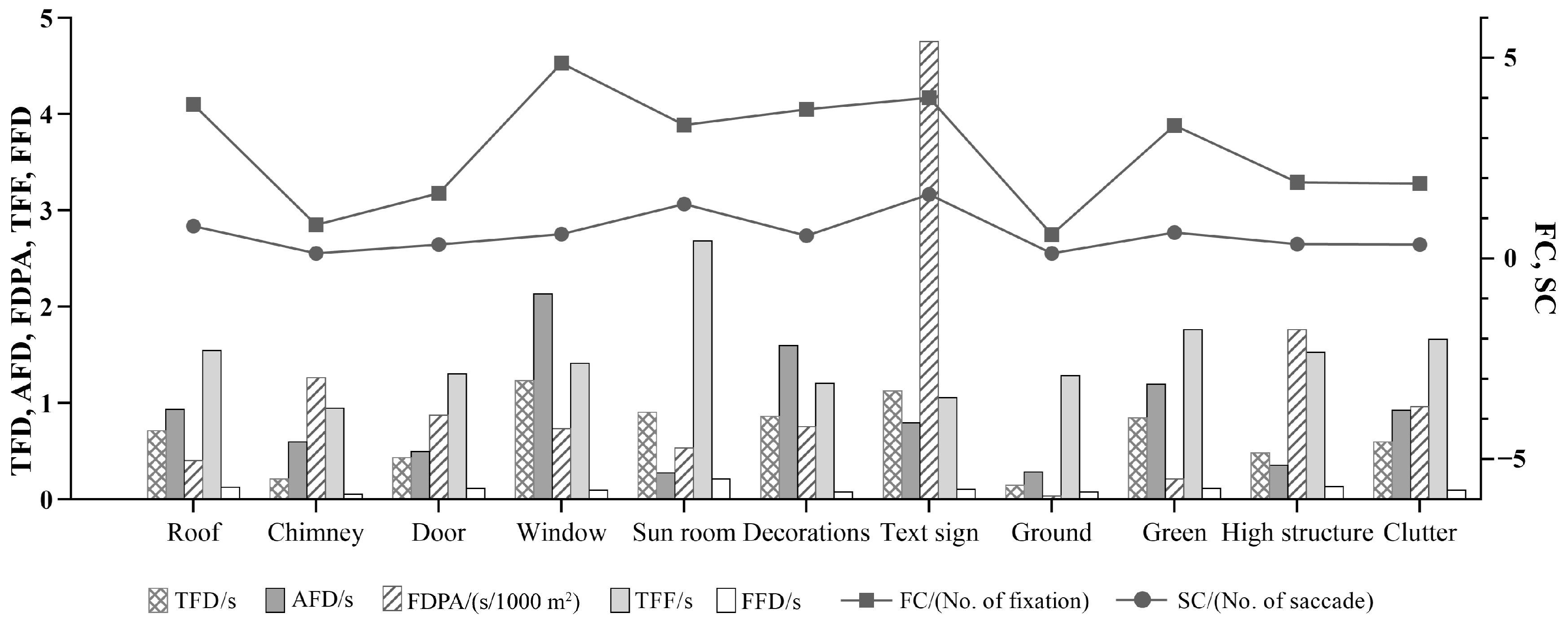
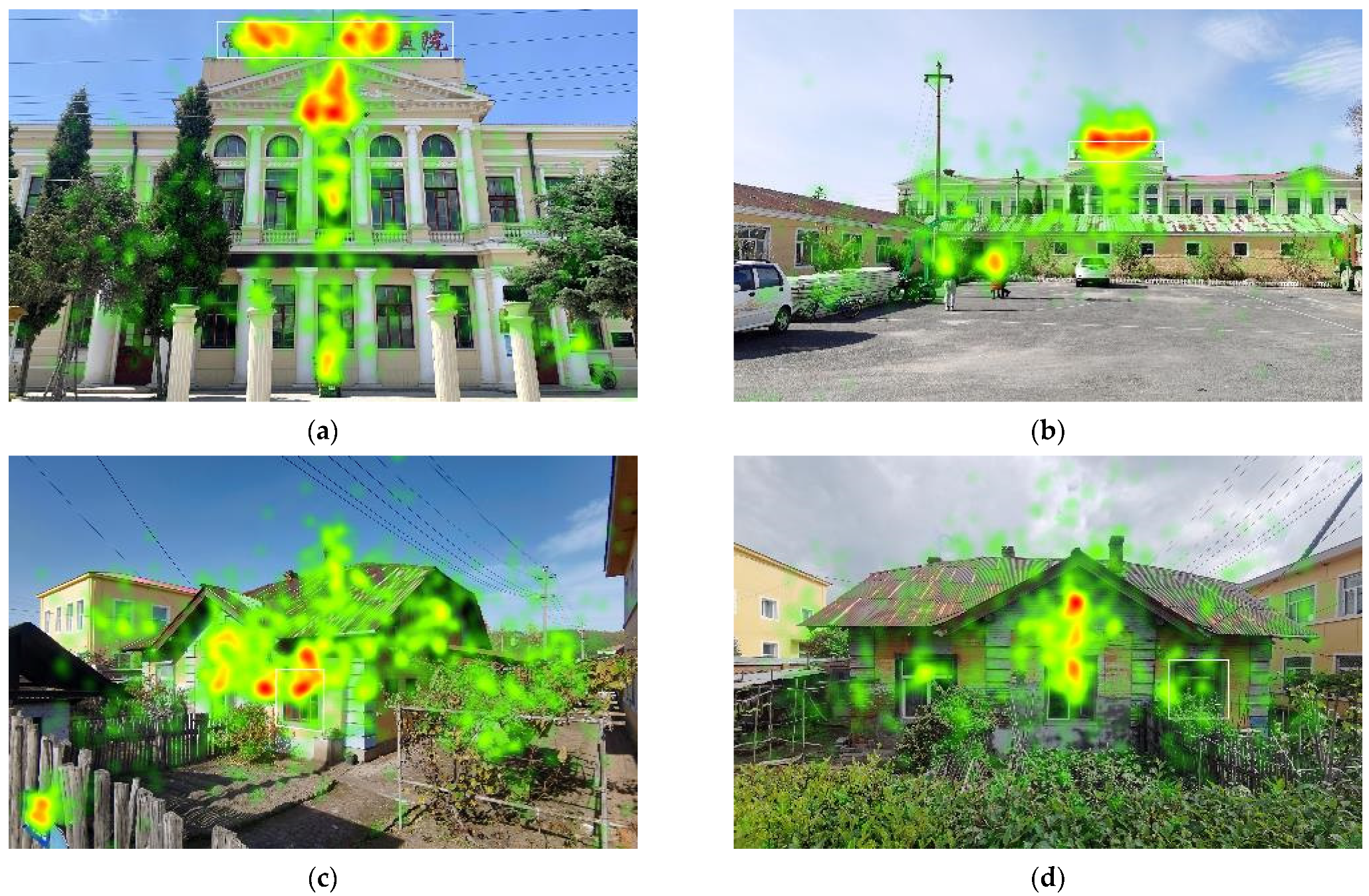
| Metrics | Abbreviation | Basic Significance | |
|---|---|---|---|
| Fixation metrics | Total fixation duration (s) | TFD | The longer the TFD was, the more the participants paid attention to the area and the more they had difficulty in processing the corresponding information. |
| Average fixation duration (s) | AFD | The longer the AFD was, the harder it was to perceive the picture. | |
| Fixation count (no. of fixation) | FC | FC reflected the participants’ ability to process the scene, the difficulty of the scene, and the participants’ interest in the content they looked at. The areas with more fixations were generally the parts that participants were more interested in. | |
| Time to first fixation (s) | TFF | It took time for the eyes to move to the area of interest (AOI). If the TFF was short, it was easier to notice an element. TFF was used to measure visual saliency. | |
| First fixation duration (s) | FFD | The longer FFD was, the more challenging it was to recognize the AOI or find it more attractive. | |
| Fixation duration per area (s/1000 m2) | FDPA | The proportion of the TFD relative to each AOI | |
| Saccade metrics | Average saccades amplitude (degree) | ASA | Referred to the average distance between saccades, usually measured as a viewing angle. Reflected the range of visual information searched. A larger ASA had a more distinct picture feature, and the participant could reach the target area directly. |
| Saccade count (no. of saccades) | SC | SC referred to the number of eye movements between fixations. Viewers in the no-disturbance stimulus condition had more saccades than those in the with-disturbance stimulus condition. | |
| Average saccades peak velocity (degree/second) | ASPV | ASPV was an index that evaluated the size of the range of information acquired by the participants and reflected the distinctive features of the picture’s information. | |
| Average pupil diameter (mm) | APD | APD correlated with the interest value of the visual stimulus. | |
| Metrics | TFD(s) | AFD(s) | FC (No. of Fixation) | TFF(s) | FFD(s) | SC (No. of Saccades) | ASPV (Degree/Second) | ASA (Degree) | APD (mm) |
|---|---|---|---|---|---|---|---|---|---|
| Overall difference (Sig.) | 0.008 ** | 0.005 ** | 0.164 | 0.776 | 0.384 | 0.048 * | 0.014 * | 0.150 | 0.009 ** |
| Differences among architectural heritage in different scenes | |||||||||
| Traditional dwelling (a) | 7.65 de | 0.27 c | 30.17 | 0.08 | 0.17 | 22.00 cde | 171.22 d | 4.70 d | 2.89 cd |
| Public building (b) | 7.45 e | 0.26 c | 30.38 | 0.07 | 0.16 | 21.17 c | 164.58 d | 4.59 | 2.82 d |
| Street (c) | 7.49 e | 0.33 abde | 27.93 | 0.09 | 0.19 | 18.76 ab | 167.20 d | 4.60 | 2.76 a |
| Public space (d) | 7.39 a | 0.27 c | 29.20 | 0.08 | 0.16 | 19.64 a | 150.92 abce | 4.18 a | 2.68 abe |
| Courtyard (e) | 7.18 abc | 0.25 c | 30.16 | 0.09 | 0.17 | 19.56 a | 167.91 d | 4.57 | 2.79 d |
| Scene | Heat Map | TFD of Elements | |
|---|---|---|---|
| Traditional dwelling | Sample 1 |  |  |
| Sample 2 |  |  | |
| Sample 3 | 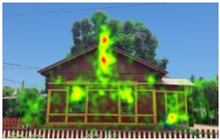 | 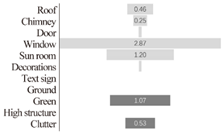 | |
| Sample 4 | 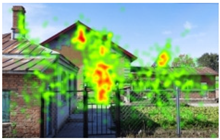 | 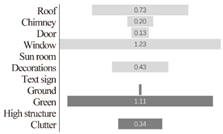 | |
| Public building | Sample 5 | 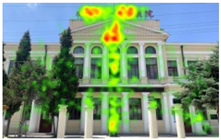 | 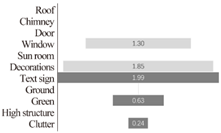 |
| Sample 6 | 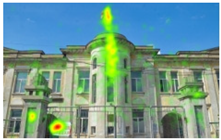 |  | |
| Sample 7 |  | 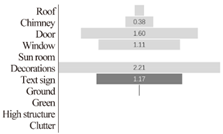 | |
| Street | Sample 8 | 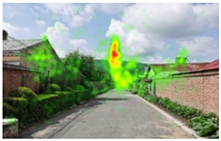 | 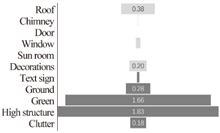 |
| Sample 9 | 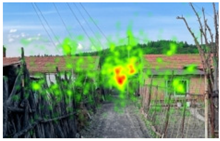 | 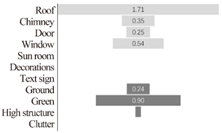 | |
| Sample 10 | 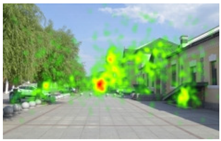 | 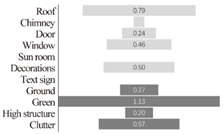 | |
| Public space | Sample 11 |  |  |
| Sample 12 |  | 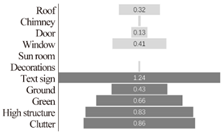 | |
| Sample 13 |  | 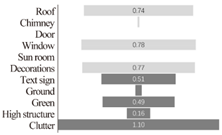 | |
| Courtyard | Sample 14 | 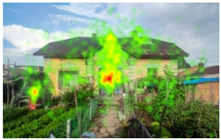 | 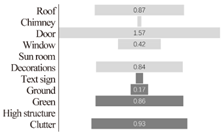 |
| Sample 15 | 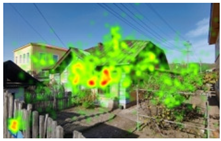 | 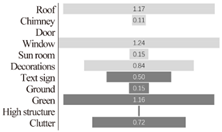 | |
| Sample 16 | 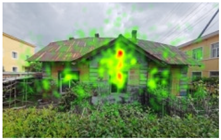 | 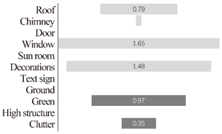 | |
| Legend | Short fixation  Long fixation Long fixation |  Architectural elements Architectural elements Environmental elements Environmental elements | |
| Metrics | TFD (s) | AFD (s) | FC (No. of Fixation) | TFF (s) | FFD (s) | FDPA (s/1000 m2) | SC (No. of Saccades) |
|---|---|---|---|---|---|---|---|
| Architectural elements | |||||||
| Roof | 0.72 | 0.94 | 3.84 | 1.55 | 0.13 | 0.41 | 0.81 |
| Chimney | 0.22 | 0.60 | 0.84 | 0.95 | 0.06 | 1.27 | 0.13 |
| Door | 0.44 | 0.50 | 1.63 | 1.31 | 0.12 | 0.88 | 0.35 |
| Window | 1.24 | 2.14 | 4.88 | 1.42 | 0.10 | 0.74 | 0.61 |
| Sunroom | 0.91 | 0.28 | 3.33 | 2.69 | 0.22 | 0.54 | 1.36 |
| Decorations | 0.87 | 1.60 | 3.72 | 1.21 | 0.08 | 0.76 | 0.57 |
| Environmental elements | |||||||
| Text sign | 1.13 | 0.80 | 4.02 | 1.06 | 0.11 | 4.76 | 1.60 |
| Ground | 0.15 | 0.29 | 0.60 | 1.29 | 0.08 | 0.04 | 0.13 |
| Greenery | 0.85 | 1.20 | 3.32 | 1.77 | 0.12 | 0.22 | 0.65 |
| High structure | 0.49 | 0.36 | 1.90 | 1.53 | 0.14 | 1.77 | 0.36 |
| Clutter | 0.60 | 0.93 | 1.87 | 1.67 | 0.10 | 0.97 | 0.35 |
| Traditional Dwelling (a) | Public Building (b) | Street (c) | Public Space (d) | Courtyard (e) | |
|---|---|---|---|---|---|
| Architectural elements | |||||
| Roof | 1.015 bd | 0.043 acde | 0.961 bd | 0.521 abce | 0.943 bd |
| Chimney | 0.468 bcde | 0.127 ad | 0.143 ade | 0.011 abce | 0.068 acd |
| Door | 0.172 ae | 0.573 acd | 0.165 be | 0.216 be | 0.517 acd |
| Window | 2.346 bcde | 1.350 acd | 0.350 abde | 0.711 abce | 1.108 acd |
| Sunroom | 0.878 e | - | - | - | 0.049 a |
| Decorations | 0.145 bde | 1.882 acde | 0.233 bde | 0.449 abce | 1.058 abcd |
| Environmental elements | |||||
| Text sign | 0.273 bcd | 1.549 ace | 0.009 abde | 1.671 ace | 0.191 bcd |
| Ground | - | - | 0.265 be | 0.203 b | 0.108 bc |
| Greenery | 0.578 bce | 0.210 acde | 1.229 abd | 0.504 bce | 0.995 abd |
| High structure | - | 0.171 cd | 0.693 b | 0.448 b | - |
| Clutter | 0.440 bcde | 0.099 acde | 0.252 abde | 0.652 abc | 0.666 abc |
| Indicators | Area/mm2 | Relative Area/% | Distance from Center/mm | Circumference/mm |
|---|---|---|---|---|
| Architectural elements | ||||
| Roof | 1989.03 | 6.78% | 41.89 | 433.66 |
| Chimney | 202.01 | 0.69% | 55.64 | 80.03 |
| Door | 620.87 | 2.12% | 60.62 | 129.70 |
| Window | 1947.17 | 6.64% | 48.39 | 511.49 |
| Sunroom | 1795.30 | 6.12% | 70.06 | 177.27 |
| Decorations | 1673.35 | 7.55% | 46.61 | 626.59 |
| Environmental elements | ||||
| Text sign | 313.00 | 1.07% | 45.26 | 95.68 |
| Ground | 4312.32 | 14.70% | 60.31 | 397.00 |
| Greenery | 4333.68 | 14.77% | 65.30 | 626.66 |
| High structure | 1118.17 | 3.81% | 65.92 | 237.19 |
| Clutter | 216.69 | 0.74% | 34.00 | 100.43 |
| TFD | AFD | FC | TFF | FFD | FDPA | SC | ||
|---|---|---|---|---|---|---|---|---|
| Area | Correlation coefficient | 0.743 ** | −0.078 | 0.744 ** | −0.055 | 0.084 | −0.269 ** | 0.756 ** |
| Relative area | Correlation coefficient | 0.740 ** | −0.079 | 0.743 ** | −0.050 | 0.091 | −0.268 ** | 0.749 ** |
| Distance from center | Correlation coefficient | −0.391 ** | 0.106 | −0.400 ** | 0.190 * | 0.058 | −0.105 | −0.371 ** |
| Circumference | Correlation coefficient | 0.424 ** | 0.520 ** | 0.448 ** | 0.553 ** | 0.546 ** | −0.327 ** | 0.314 ** |
Publisher’s Note: MDPI stays neutral with regard to jurisdictional claims in published maps and institutional affiliations. |
© 2022 by the authors. Licensee MDPI, Basel, Switzerland. This article is an open access article distributed under the terms and conditions of the Creative Commons Attribution (CC BY) license (https://creativecommons.org/licenses/by/4.0/).
Share and Cite
Li, N.; Zhang, S.; Xia, L.; Wu, Y. Investigating the Visual Behavior Characteristics of Architectural Heritage Using Eye-Tracking. Buildings 2022, 12, 1058. https://doi.org/10.3390/buildings12071058
Li N, Zhang S, Xia L, Wu Y. Investigating the Visual Behavior Characteristics of Architectural Heritage Using Eye-Tracking. Buildings. 2022; 12(7):1058. https://doi.org/10.3390/buildings12071058
Chicago/Turabian StyleLi, Na, Shanshan Zhang, Lei Xia, and Yue Wu. 2022. "Investigating the Visual Behavior Characteristics of Architectural Heritage Using Eye-Tracking" Buildings 12, no. 7: 1058. https://doi.org/10.3390/buildings12071058
APA StyleLi, N., Zhang, S., Xia, L., & Wu, Y. (2022). Investigating the Visual Behavior Characteristics of Architectural Heritage Using Eye-Tracking. Buildings, 12(7), 1058. https://doi.org/10.3390/buildings12071058






